How the Next Phase of the Second Avenue Subway Can Build a Better East Harlem

A groundbreaking in East Harlem (photo: John McCarten/City Council)
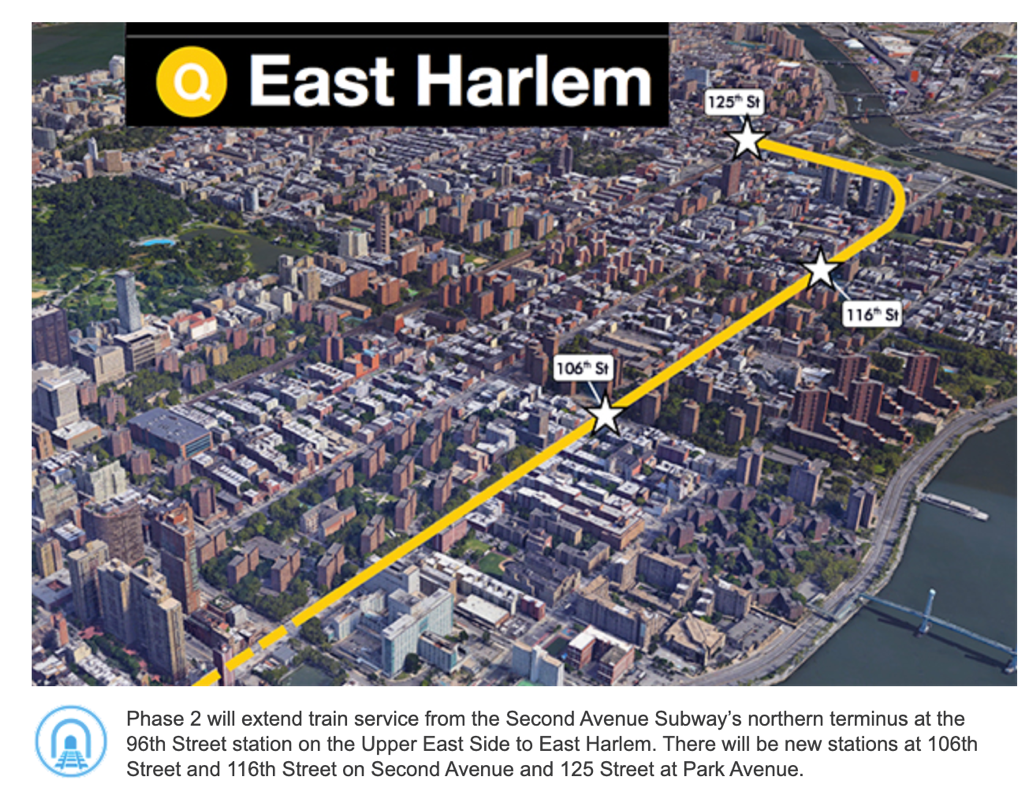
(Housing projects and tenements surround the $6 billion Second Avenue Subway Phase 2 planned route (MTA Capital Division))
Plans are advancing rapidly for the 1.5 mile Second Avenue (Q) Subway from 96th to 125th Streets. The estimated cost of the segment’s three new stops (106th, 116th, and 125th streets) is about $6 billion, with the likelihood of an even higher price tag by the planned opening date of 2029. The project has strong support from city, state, and federal officials and will benefit from the federal Infrastructure Investment and Jobs Act (2021).
The Second Avenue Subway three-stop extension will likely become the nation’s most expensive urban mass transit project. Still, it will fail to benefit many city residents unless significant zoning changes are made to the neighborhood.
MTA capital planners estimate that the East Harlem extension would, at best, add “an additional 100,000 daily riders.” Moreover, many of these subway riders are likely to be East Harlem residents shifting from the existing Lexington Avenue Subway (4/5/6) to the more convenient Second Avenue extension further east. These ridership projections are underwhelming in the context of a subway system back to carrying over 3 million riders a day on most weekdays.
High-quality planning and significant upzoning could boost ridership on the new line and remake East Harlem into a place that more comfortably accommodates current and future residents–of all income levels. The New York City Department of City Planning, the MTA and its New York City Transit division, and NYCHA need to plan proactively and “think big” for the neighborhood’s future.
Density Is the Solution, Not the Problem
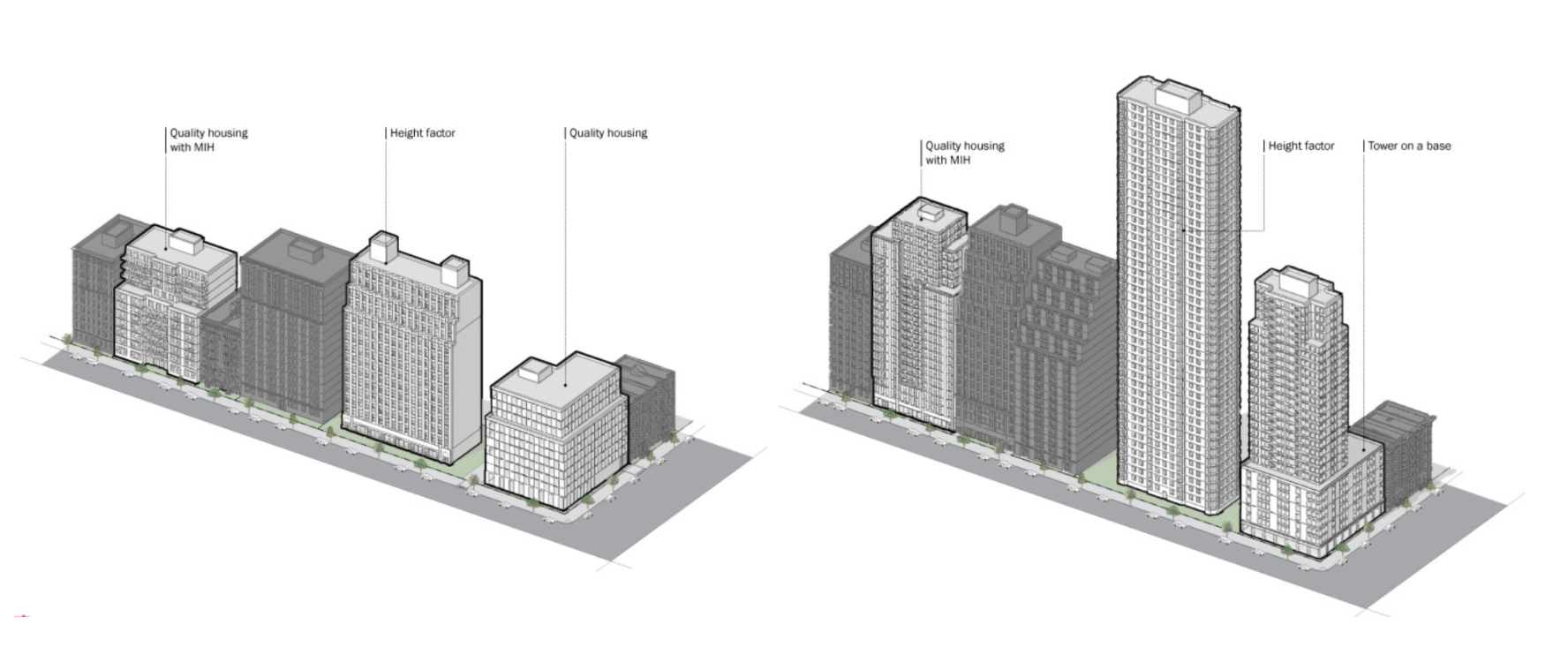
(R8 zoning on the left and R10 zoning on the right. These high-density zoning designations, and contextual variations (R8A, R8B, R10A, etc.), animate the Upper East Side below 96th street. See NYC Planning for full descriptions.)
The first phase of the Second Avenue line (with stops at 72nd, 86th, and 96th Streets) serves the Upper East Side. This affluent district is characterized by large apartment buildings permitted primarily by R8 and R10 zoning. Major institutions like Hunter College and hospital complexes attract thousands of daily subway commuters. The first stops of the Q Line quickly attracted about 200,000 riders per day, and patronage is rebounding amid pandemic recovery.
This strong ridership was predictable. Upscale, high-density redevelopment of the East Side tenements has been a civic priority since the 1940s. Big, bulky apartment buildings are often frowned upon in NIMBY circles, but the vitality of the Upper East Side demonstrates the value of concentrating hundreds of thousands of people together in suitable housing near transit. The apartment buildings frequently have stores at the base and wide sidewalks. Many remaining tenement buildings have been renovated for higher-income renters. Population density of this type is one of New York’s enduring assets–and a key to its rebounding fortunes in the post-covid era.
Extending the subway line in East Harlem along Second Avenue between 96th Street and 125th Streets is a different story. The neighborhood's threadbare low-rise tenements remain a dominant feature. Developers, due to redlining, ignored the area for decades. Overcrowded apartments, rent-burdened families, and building code violations in the area are well documented. The longstanding Puerto Rican and Black communities in the area have thrived despite widespread housing exploitation and poor living conditions.
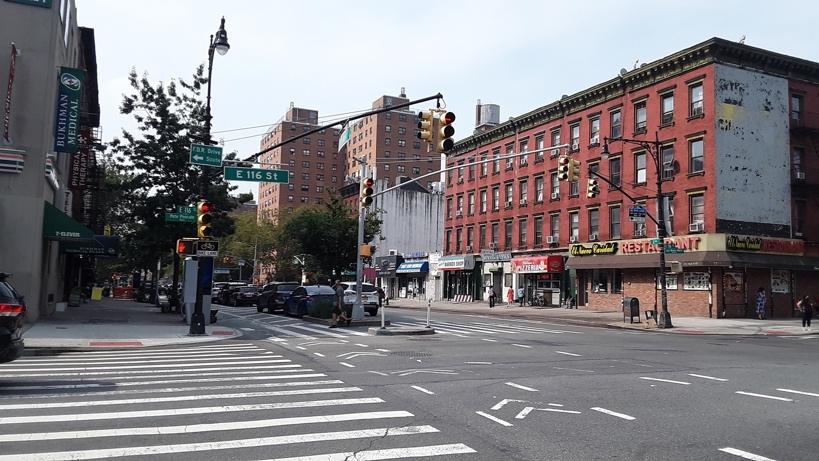
(Typical East Harlem street scene.)
The city and NYCHA redeveloped sections of the district since the 1940s, but these efforts have lost their luster. East Harlem retains one of the nation’s largest concentrations of “tower in the park” public housing. The iconic red-brick towers, built far below the allowable zoning envelope, were once a showpiece of the city’s social vision. Today, however, growing maintenance issues, because of limited capital and operating subsidies, have undermined resident quality of life.
Despite their Manhattan location and the Lexington Subway line running nearby, planners built the NYCHA housing projects at low-density levels with acres of lawn and surface parking. The local stations through which the current Lexington Subway runs (103rd, 110th, and 116th Streets) have modest ridership compared to stations below 96th Street. Very few NYCHA developments have stores at ground level, creating empty zones along major Avenues.
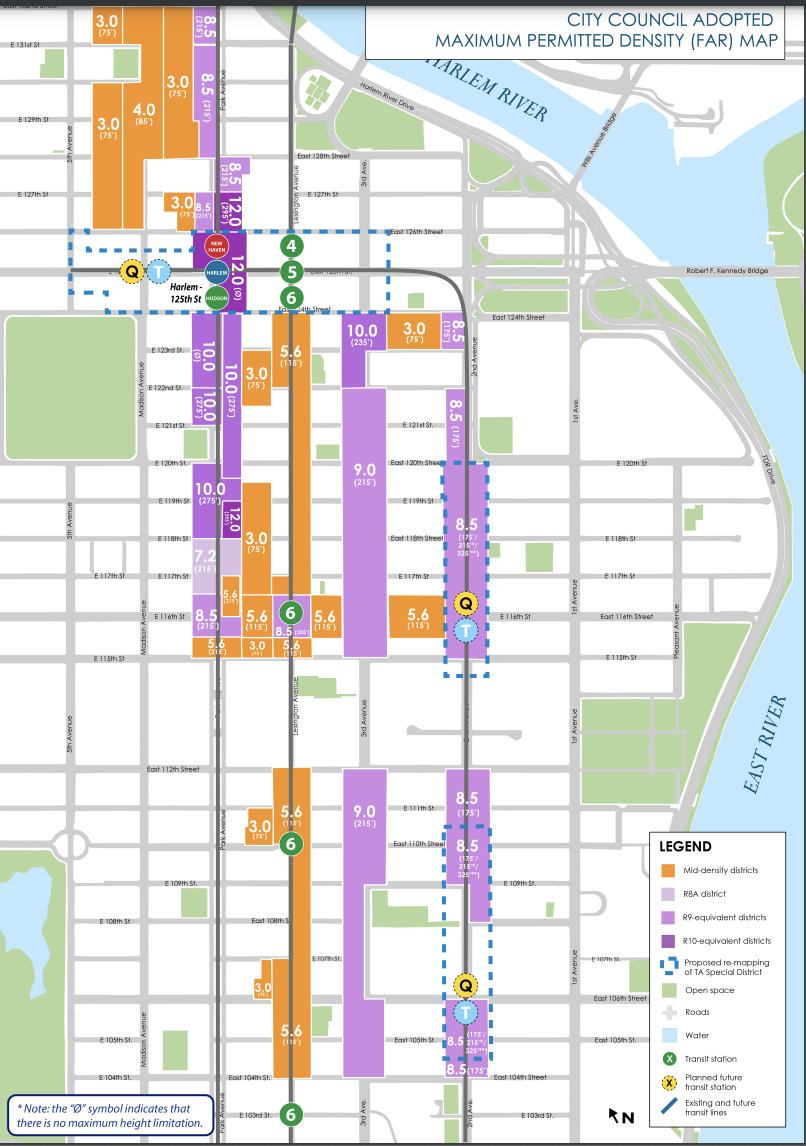
(2017 Rezoning of East Harlem)
The East Harlem rezoning approved in 2017 did what it could, given anti-density politics, to consider the future impact of the Second Avenue Subway. But most of the neighborhood remained R7, and only a few narrow corridors along major avenues were rezoned to R9 and higher density commercial.
The expectations in East Harlem for new housing in the rezoned corridors is about 3,500 units, only some of which would be affordable under the MIH (Mandatory Inclusionary Zoning) requirements. These new apartments will not compensate for subway-related gentrification or drive much new ridership. Most new housing in the neighborhood outside the rezoned areas will probably be “as-of-right” market housing, taking advantage of the new subway stops, with few options for low-income tenants.

(The dominant R7 zoning (in yellow) of East Harlem; on the right is typical R7 massing. (NYC Planning))
Density for Living and Transit
East Harlem needs to be upzoned on a more comprehensive basis to make the most of the multi-billion dollar subway investment. Given the density of transit-oriented areas below 96th Street, R7 is not making the best use of this valuable new subway resource.
The rezoning should be at levels similar to the dense neighborhoods (R8-R10) below 96th Street on the Second Avenue Subway corridor. Only much greater residential zoning in East Harlem can attract developers and drive the creation of sufficient market housing to cross-subsidize thousands of additional low-cost units in East Harlem. These regulations should emphasize the deep affordability option under MIH to make sure the number of units and rent levels align with the neighborhood's needs. Neighborhood priorities will guarantee a fair share of these new affordable units for existing and future low-income neighborhood residents from redeveloped tenements.
With so much of the land tied up in low-density NYCHA public housing, rezoning alone will be insufficient to change much of the area. City leaders need to push harder on the redevelopment options for NYCHA projects in this specific area. Redevelopment isn’t suitable for many NYCHA developments elsewhere, and renovation is long overdue in almost all NYCHA buildings. Yet the logic in favor of comprehensive redevelopment is overwhelming for East Harlem because of the Second Avenue Subway project.
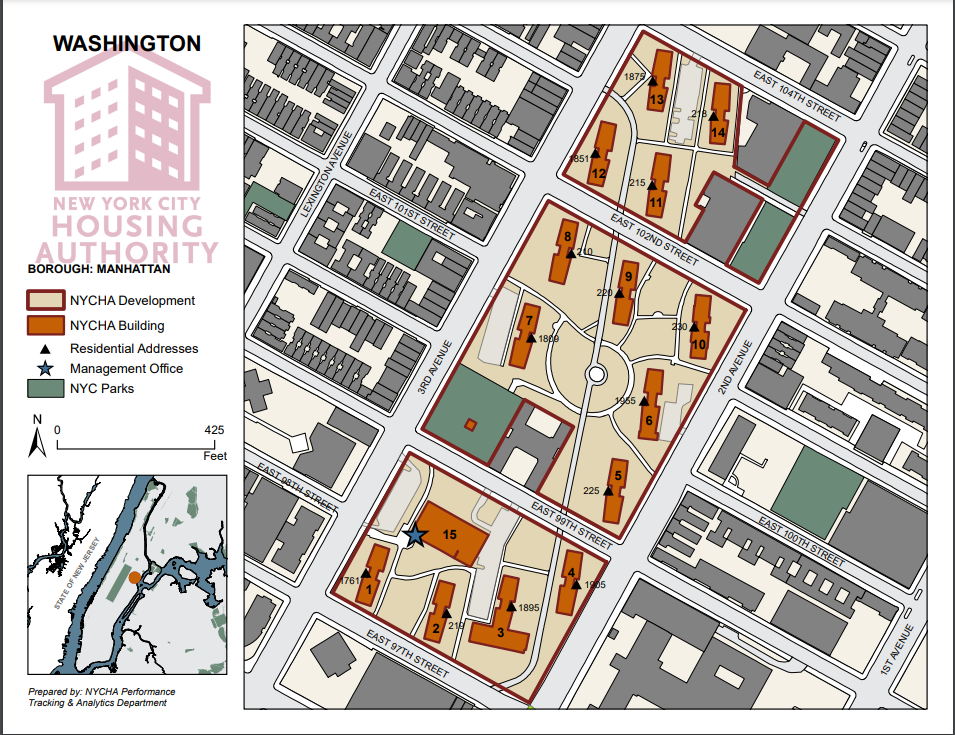
(Washington Houses is 86.3% open space, much of it lawns or surface parking. (NYCHA))
An antique East Harlem NYCHA development like Washington Houses has 1,151 apartments housing only 3,334 residents on 20.82 acres. That is a modest number of potential riders from such a large slice of Manhattan land. In contrast, rebuilding the housing project could house both current NYCHA residents and many times the number of future residents of various income levels.
Washington Houses is just one of many possible NYCHA projects in the area that could benefit from a redesign. Redeveloped projects could include thousands of new apartments, ground-floor retail, and social resources such as new schools and community centers. A selected portion of NYCHA open spaces could be preserved and then redesigned as New York City parks to serve their neighborhoods as community assets. The neighborhood would become much more vibrant with changes like these.
Substantial protections would be required to make sure NYCHA tenants get new apartments. Given the success of NYCHA organizing around RAD/PACT and infill development, it is reasonable to believe such protections could be secured from NYCHA, HUD, and private developers. The redevelopment would also permanently solve the longstanding mold and maintenance issues by leveraging private sector investment to rebuild from the ground up. Hopes for a federal bailout for NYCHA seem more remote by the day–yet conditions in many buildings continue to decline.
As recently proposed but now abandoned at NYCHA’s Fulton Houses, a staged redevelopment could ensure that residents are rehoused respectfully and systematically during the process. NYCHA residents would move into the first new building constructed on-site (on a former parking lot, for instance). Their vacated tower could then be demolished and redeveloped on a mixed-income model for tenants from the next NYCHA tower (and so on). This scenario is practical given the small number of current NYCHA residents compared to the future capacity of much larger buildings that would rise under rezoning.
Redevelopment may have some political capital in the new administration. Mayor Adams has not yet outlined a clear vision for NYCHA or affordable housing but is a fan of big ideas. Jessica Katz, the mayor’s new Chief Housing Officer, has been outspoken in her admiration for London’s public housing regeneration programs. As Executive Director at Citizens Housing and Planning Council, she published CHPC’s report on “Public Housing Revolution” that highlighted how redevelopment in London created “entirely new neighborhoods . . . out of what were once superblocks of poorly maintained public housing.”
Redevelopment of East Harlem private “tower in the park” developments, most built initially with government aid, could follow a similar regeneration model with city encouragement through new zoning, incentives, and tenant protections. The Franklin Plaza Apartments, for instance, stretching from 106th to 108th Streets, could house many more residents who might like to live near the new subway stop at 106th Street.
The likelihood of planned densification of East Harlem, as proposed here, is remote given the dominant anti-development sentiment. Brave city leaders and activists will need to speak up for the needs of future city residents who could be accommodated under this proposal (or something similar). City leaders must also make sure that New Yorkers get their fair share of social benefits in return for billions in public transit investments. Deeply affordable Mandatory Inclusionary Housing requirements and public housing regeneration are two ways to achieve this goal.
Leaving current zoning/density in advance of the subway extension is a vote for market-driven gentrification. Big money will inevitably follow the subway lines into East Harlem. Left to their own devices, developers will add few affordable units in new buildings permitted under current zoning. Many of the existing tenement apartments will become more expensive. Most affordable housing interests will be priced out of the neighborhood. Fancy new buildings will rise around decaying NYCHA towers, as often happens elsewhere. Yes, these new private buildings will be less bulky than under a major rezoning, but that does not mean social equity will have been achieved.
The East Side Access project is a cautionary tale in failing to integrate transit and density. The $11 billion MTA megaproject bringing Long Island Rail Road riders directly to Grand Central moved ahead without upzoning the suburban towns on Long Island that benefit from this luxurious new asset. The city rezoned East Midtown for massive new office buildings and yet leaders left single-family home zoning dominant in the suburbs. The most expensive transit project in the nation will thus underperform because the potential residential market for new transit services remained artificially restricted by local governments. Without significant changes to land use in East Harlem, transit planning history will repeat itself with the Second Avenue extension.
***
Nicholas Dagen Bloom is Professor of Urban Policy and Planning at Hunter College and author of Public Housing That Worked (2008) and the forthcoming The Great American Transit Disaster (Chicago, 2023). He was a co-curator of the Housing Density show at the Skyscraper Museum.
***
Have an op-ed idea or submission for Gotham Gazette? Email This email address is being protected from spambots. You need JavaScript enabled to view it.
In This Moment, New York Needs The AAPI Equity Budget

Gov. Hochul at a rally (photo: Don Pollard/Office of Governor Kathy Hochul)
Over the past two years, Asian Americans have learned to look over our shoulders on the subway platform and keep one earbud out as we walk down the street. An onslaught of anti-Asian hate incidents has instilled fear in our community, from our children to our elders, influencing how we go about our daily lives.
Seniors are afraid to leave their homes to obtain basic services, Asian Americans have experienced the highest rates of unemployment, and non-native English speakers struggle to navigate resources in a language they do not understand. Since the beginning of the COVID-19 pandemic, New York's Asian American and Pacific Islander (AAPI) community has been acutely targeted and isolated, and we are still bearing the brunt of its lingering effects.
Within the next several days, New York State will finalize a budget that will shape the lives of all its residents. The budget is a test of what our government prioritizes and values. State government leaders have an opportunity to combat the marginalization, violence, and isolation the Asian American community is facing, by including the AAPI Equity Budget in the upcoming budget deal.
The AAPI Equity Budget is a detailed $64.5 million policy that would fund programs to improve the lives of AAPI communities throughout New York State. From mental health care to education and economic initiatives, the Equity Budget would address a wide range of needs in New York’s Asian communities. We are asking for this historic investment because our community has been systemically underfunded for years even while growing at the fastest rate of any racial group in the state, creating a chasm between what our service-providers and community-based organizations need and what they’re receiving. This situation has further been exacerbated by a relentless surge in hate crimes and the economic toll of the pandemic.
The 2.1 million Asian Americans who call New York home account for 10.8% of the total population of the state. We are the fastest growing group, having increased by 37.6% since 2010. However, even as our community has grown rapidly, we have been left unsupported.
Poverty affects 1 in 5 Asian New Yorkers, owing to social isolation and a lack of access to government services. If Asian Americans do not speak English well, which is true for more than 40% of our community, they are more likely to live in poverty. This language barrier makes accessing government programs, health care, and economic opportunities even more difficult. It is past time for New York to recognize this reality and provide the services that our diverse community needs.
This is where the AAPI Equity Budget comes in. The majority of its funds would be distributed to existing community groups already working to uplift AAPI populations. Hundreds of ethnic groups and languages make up the pan-Asian community in New York, and allocating state funds to organizations already deeply connected to these distinct communities would ensure that resources are directed to those in greatest need.
For example, the AAPI Equity Budget would support organizations offering culturally competent mental health care, through providers who understand AAPI experiences and speak our languages. This is especially important given the trauma that anti-Asian hate-based violence has inflicted on victims – and the fear these crimes have instilled in all of us.
The AAPI Equity Budget would fund language classes, a pre-K through 12th grade AAPI educational curriculum, senior services to reach our most isolated, food security, workforce development, safety against gender-based violence, civic engagement for a rapidly growing group, health care, access to covid vaccines and treatments, and countless other community needs.
This funding is critical to ensuring support, safety, and wellbeing for Asian New Yorkers at a time when our community is experiencing rapid population growth, persistent anti-Asian hate, increased isolation, and economic hardship brought on by the pandemic. The New York State budget must address the systemic underfunding of AAPI communities in the face of sustained increases in demand.
Last year, California passed a similar measure. It is now up to New York, as the state with the second-largest Asian population, to step-up. We ask New York State’s Governor, Senate, and Assembly to show their support for Asian American communities as we face one of the most challenging times in recent memory, and pass the AAPI Equity Budget.
***
Jo-Ann Yoo is the Executive Director of the Asian American Federation, the largest AAPI umbrella leadership organization in New York. John Liu is a New York State Senator. On Twitter @AAFederation and @LiuNewYork.
***
Have an op-ed idea or submission for Gotham Gazette? Email This email address is being protected from spambots. You need JavaScript enabled to view it.
New York's Home Care System is on the Verge of Collapse; It Can Be Fixed in the State Budget
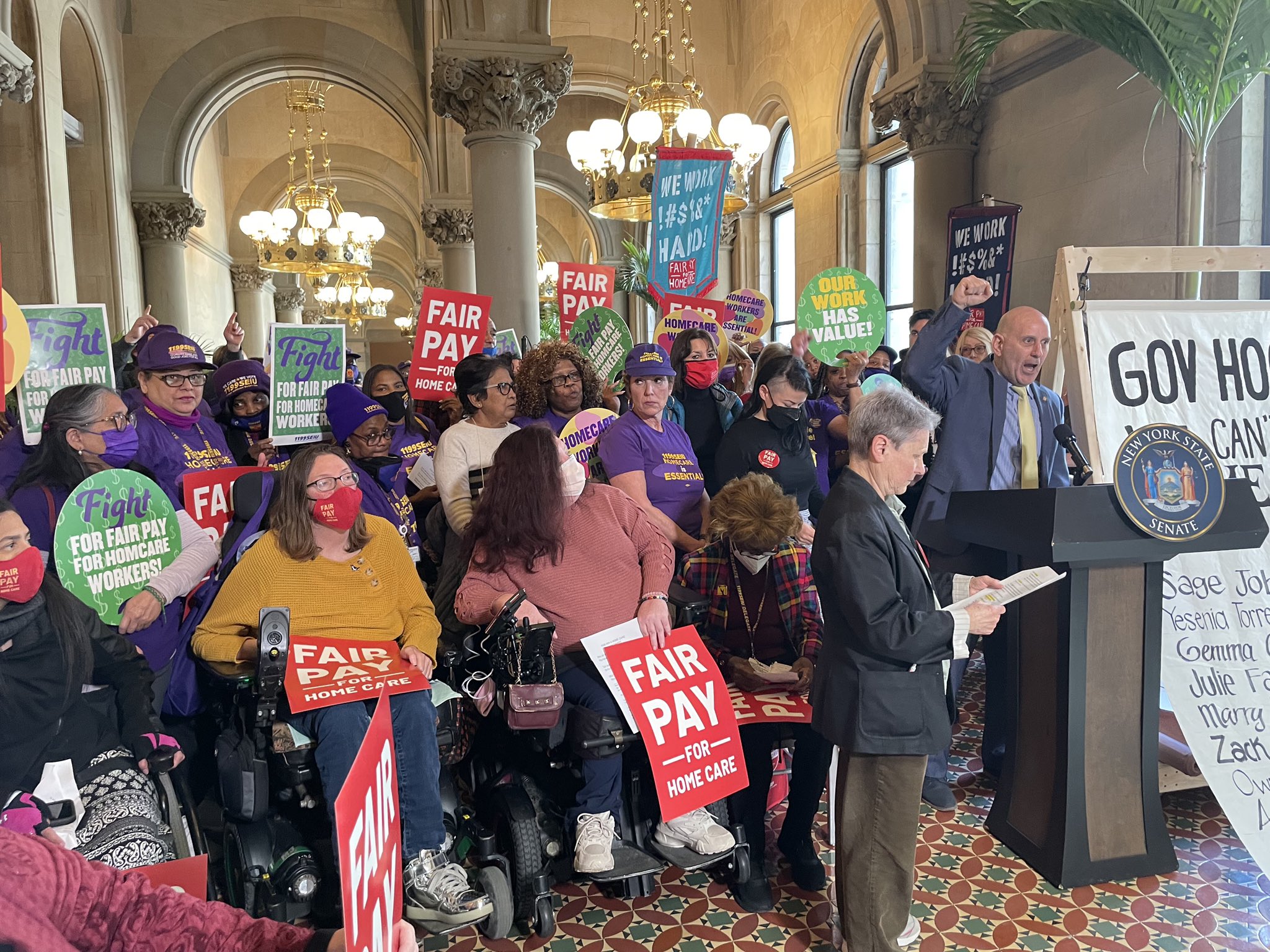
A rally for Fair Pay for Home Care (photo: @JFREJNYC)
For people with disabilities and older New Yorkers, home care is the lifeline that enables them to stay in their homes and lead independent lives. Right now, the home care sector faces an alarming workforce crisis, jeopardizing the availability of at-home assistance and community living that enable people with disabilities and older New Yorkers to live their lives with dignity.
We are facing a growing demand to increase the home care workforce. While agencies managed to continue essential in-home care throughout the pandemic, we now face a nearly insurmountable challenge, with nearly one in six home care jobs currently left unfilled. It is estimated that 26,510 new home care workers will be needed just to keep up with increasing demand in New York, and an additional 71,680 workers are required each year to address high annual turnover. If this issue is left unaddressed, vulnerable New Yorkers across the state will be left without needed care in their homes.
The remedy is clear: it’s imperative that advocates, providers, workers, consumers, families, and unions alike come together to support several new pieces of legislation that offer long-term, sustainable change in an industry that is vital to our nation’s most vulnerable populations. And that starts in the state budget deal being negotiated in Albany.
The Fair Pay for Home Care bill (S5374A May/A6329A Gottfried) would raise home care worker pay to 150% of the highest area minimum wage across the State. By increasing home care wages, the Fair Pay for Home Care bill would make home care compensation more attractive, with the goal of addressing worker burnout and incentivizing new people to join the workforce.
Currently, home care agencies face restrictive limitations on the compensation that workers receive because many are 100% funded by Medicaid. Importantly, the Fair Pay bill contains provisions designed to ensure Medicaid reimbursement supports fair pay. To carry out the bill’s purpose and support these improvements, New York State must enact a budget that fully funds these reimbursement provisions. Home care agencies acting alone cannot rectify the problem.
This session, the Legislature is also considering another home care bill (A3145A Epstein/S359A Persaud) that aims to address another flaw in the current system. If passed, this bill would split all 24-hour shifts for home care workers into two, separate 12-hour shifts. The bill would effectively end legacy practices that reimbursed Medicaid-funded nonprofit home care agencies for 13 hours of a given worker’s pay in a 24-hour shift, with the understanding that the other 11 hours were unpaid time for sleep and meals.
These antiquated government policies have, for far too long, placed an undue burden on New York’s home care workers. In order to make this bill work for agencies and ensure that it does not lead to a reduction in care for people who need care in their homes, the bill must change Medicaid reimbursement rules and managed care service authorization, helping to ensure there are sufficient workers to care for the most vulnerable. As with fair pay, home care agencies alone cannot solve these challenges.
In many ways, the Fair Pay for Home Care bill is a complement to the shift-rule bill, ensuring that Medicaid resources are made available to fund these structural and comprehensive reforms to home care compensation. Bills like these represent a timely and much-needed step in the right direction – but in order for these reforms to be successful, both bills must work in tandem.
If we hope to build an equitable and caring home care system to meet growing demand, one fact remains abundantly clear: we must pass systemic reforms which come from government leaders. Time is of the essence.
On Friday, March 18, home care agencies, workers, and consumers came together to rally in front of the governor’s office in New York City to fight for the Fair Pay for Home Care bill. Our coalition, which includes stakeholders from across the home care sector, called on our executive and legislators to invest in the future of the home care industry and our communities, empowering home care workers with the tools and resources required to provide the best care possible for people in need across New York State. We’ve relied on home care workers’ unconditional kindness, generosity, and passion for caretaking for too long. It’s time for Albany to equitably and fairly compensate home care workers.
***
Wayne Ho is President and Chief Executive Officer of the Chinese-American Planning Council, Inc. Kathryn Haslanger is CEO of JASA.
***
Have an op-ed idea or submission for Gotham Gazette? Email This email address is being protected from spambots. You need JavaScript enabled to view it.




